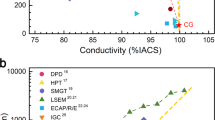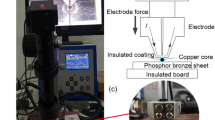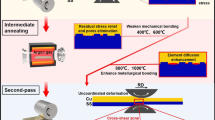Abstract
This study is made to obtain controllable and improved microstructural properties of a material obtained by stacking copper wires and then combining them with hot diffusion welding. The mechanical performance of the new approach to obtain a copper billet was assessed and accordingly the diffusion welding parameters were optimized. Samples with a dimension of 60×40×5 mm were produced by stacking. Copper wires with different diameters were stacked in the same direction and welded with hot diffusion welding under 69.5-139-208.5 MPa pressures, for 20-60-90 minutes, at 600 °C. Strength of the bonding was tested by bending and microhardness tests. In addition, the diffusion interface was examined by optical microscope and SEM. The interfacial bond strength after welding increased with temperature, pressure and time. Especially, the increase in diffusion time actuated the formation of common grains in the fusion area by decreasing or completely eliminating the interfaces of the wires.
Similar content being viewed by others
References
K. I. Mori, N. Bay, L. Fratini, F. Micari and A. E. Tekkaya, Joining by plastic deformation, CIRP Ann. — Manuf. Technol., 62(2) (2013) 673–694.
M. Rosso, Ceramic and metal matrix composites: Routes and properties, J. Mater. Process. Technol., 175(1–3) (2006) 364–375.
I. Tubert-Brohman, W. Sherman, M. Repasky and T. Beuming, Improved docking of polypeptides with Glide, J Chem Inf Model., 53(7) (2013) 1689–1699.
J. Sakamoto, A. Kisor, T. Caillat, L. Lara, V. Ravi, S. Firdosy and J.-P. Fleuiral, Mo/Ti Diffusion Bonding for Making Thermoelectric Devices, NASA Tech Briefs, July (2007).
M. Abbasi and M. R. Toroghinejad, Effects of processing parameters on the bond strength of Cu/Cu roll-bonded strips, J. Mater. Process. Technol., 210(3) (2010) 560–563.
N. Bay, Cold pressure welding — the mechanisms governing bonding, Journal of Manufacturing Science and Engineering, 101(2) (1979) 121–127.
L. Li, K. Nagai and F. Yin, Progress in cold roll bonding of metals, Science and Technology of Advanced Materials, 9(2) (2008) 023001.
W. Zhang and N. Bay, Cold welding theoretical modeling of the weld formation, Welding Journal, 76 (1997).
W. Zhang, N. Bay and T. Wanheim, Influence of hydrostatic pressure in cold-pressure welding, CIRP Annals, 41(1) (1992) 293–297.
M. Pawlicki, T. Drenger, M. Pieszak and J. Borowski, Cold upset forging joining of ultra-fine-grained aluminium and copper, Journal of Materials Processing Technology, 223 (2015) 193–202.
X. X. Wu, X. Y. San, X. G. Liang, Y. L. Gong and X. K. Zhu, Effect of stacking fault energy on mechanical behavior of cold-forging Cu and Cu alloys, Materials & Design, 47 (2013) 372–376.
S. Mellul and J. Chevalier, Interfacial phase transitions and bonding in the Cu/Al2O3 system, Philosophical Magazine A, 64(3) (1991) 561–576.
J. Ouyang, E. Yarrapareddy and R. Kovacevic, Microstructural evolution in the friction stir welded 6061 aluminum alloy (T6-temper condition) to copper, Journal of Materials Processing Technology, 172(1) (2006) 110–122.
X. Wu, T. Liu and W. Cai, Microstructure, welding mechanism, and failure of Al/Cu ultrasonic welds, J. Manuf. Process, 20(Part 1) (2015) 321–331.
H. R. Akramifard, M. Shamanian, M. Sabbaghian and M. Esmailzadeh, Microstructure and mechanical properties of Cu/SiC metal matrix composite fabricated via friction stir processing, Materials & Design (1980–2015), 54 (2014) 838–844.
S. D. Meshram, T. Mohandas and G. M. Reddy, Friction welding of dissimilar pure metals, Journal of Materials Processing Technology, 184(1–3) (2007) 330–337.
B. Liu, Y. Tian, C. Wang, R. An and Y. Liu, Extremely fast formation of Cu e Sn intermetallic compounds in Cu/Sn/Cu system via a micro-resistance spot welding process, J. Alloys Compd., 687 (2016) 667–673.
A. Hill and E. R. Wallach, Solid-state diffusion bonding, Acta Met., 37(9) (1989) 234–249.
W. Hu, D. Ponge and G. Gottstein, Origin of grain boundary motion during diffusion bonding by hot pressing, Mater. Sci. Eng. A, 190(1–2) (1995) 223–229.
W. Cai, G. Daehn, A. Vivek, J. Li, H. Khan, R. Mishra and M. Komarasamy, A state-of-the-art review on solid-state metal joining, Proceedings of the ASME 2018 13th International Manufacturing Science and Engineering Conference. Volume 2: Materials; Joint MSEC-NAMRC-Manufacturing USA, College Station, Texas, USA, June 18–22 (2018) V002T04A044.
M. Pouranvari, A. Ekrami and A. H. Kokabi, Effect of bonding temperature on microstructure development during TLP bonding of a nickel base superalloy, Journal of Alloys and Compounds, 469 (2009) 270–275.
Y.-S. Kwon, J.-S. Kim, J.-S. Moon and M.-J. Suk, Transient liquid phase bonding process using liquid phase sintered alloy as an interlayer material, Journal of Materials Science, 35 (2000) 1917–1924.
S. B. Dunkerton, Diffusion bonding—An overview, D. J. Stephenson (eds), Diffusion Bonding 2, Springer, Dordrecht (1991).
F. William, Emsworth and W. L. Horigan, Jr., Process for Diffusion-Bonding, Pittsburgh, USA3197858, United States Patent Office (1965).
E. Akca and A. Gursel, The importance of interlayers in diffusion welding — A review, Periodicals of Engineering and Natural Sciences (PEN), 3(2) (2015) 12–16.
S. Çelik and İ. Ay, Diffusion welding under protective gas atmosphere and its application, Tr. J. of Engineering and Environmental Science, 23 (1999) 63–70.
T. Sethilvelan, Mechanical and metallurgical properties of diffusion bonded AA2024 aluminium alloy and commercial grade copper, Mechanical Engineering, 38 (2011) 4283–4289.
M. J. Fernandus, T. Senthilkumar and V. Balasubramanian, Developing temperature — time and pressure — time diagrams for diffusion bonding AZ80 magnesium and AA6061 aluminium alloys, Mater. Des., 32(3) (2011) 1651–1656.
B. T. Gietzelt, V. Toth, A. Huell and R. Dittmeyer, Determining the dependence of deformation during diffusion welding on the aspect ratio using samples made of SS 304 (1.4301), Advanced Engineering Materials, 304 (2016) 1–8.
R. D. Askeland, The Science and Engineering of Materials, Third Edition, Boston: PWS Publishing Company (1994).
W. D. Callister, Fundamentals of Materials Science and Engineering, 5th ed., New York, John Wiley & Sons Inc (2001).
K. Siva Kishore Babu, B. Koteswararao, Y. Suresh and D. Ravi, Analysis of quality in solid state welding (copper-copper) by using NDT and DT by altering physical properties at constant time, Materials Today: Proceedings, 4(8) (2017) 7351–7356.
M. Morales et al., Mechanical characterization of copper-copper wires joined by friction welding using instrumented indentation technique, J. of Materi Eng and Perform, 23 (2014) 3941–3948.
X. F. Ang, A. T. Lin, J. Wei, Z. Chen and C. C. Wong, Low temperatıre copper-copper thermo compression bonding, Proceedings of the 10th Electronics Packaging Technology Conference (EPTC) (2008) 399–404.
Acknowledgments
The authors declare that they have no known competing financial interests or personal relationships that could have appeared to influence the work reported in this paper.
Author information
Authors and Affiliations
Corresponding author
Additional information
Ömer Barışkan Yasan received his B.S. in Mechanical Engineering from Ercies University, Kayseri, Turkey, in 2010 and Hacettepe Uniersity, Ankara, Turkey, in 2013. He is currently working towards the Ph.D. in Mechanical Engineering and is a research assistant at Erciyes University. His research interests include 3D printing, self-lubricated materials, metal matrix composites and diffusion welding.
Sedat Özden received his B.S. in Mechanical Engineering from Middle East Technical University, Ankara Turkey in 1985 and MPhil and Ph.D. in Mechanical Engineering from The University of Ulster, Belfast, UK in 1994. 2018. He is currently working in the Mechanical Engineering Department at Erciyes University, Kayseri, Turkey. His research interests include polymeric materials, composite materials, tribology and the design of machine elements.
Fehmi Nair received his B.S. in Mechanical Engineering Department from Fırat University, Elazig, Turkey, in 1992, M.S. and Ph.D. from Erciyes University Mechanical Engineering in 1996 and 2005, respectively. He is an Associate Professor at Kayseri Erciyes University, Mechanical Engineering. His research interests include manufacturing technologies, production and characterization of metal matrix composites, and tribology.
Rights and permissions
About this article
Cite this article
Yasan, Ö.B., Özden, S. & Nair, F. Investigation of the mechanical properties of the diffusion welded copper wires stacked in the same direction. J Mech Sci Technol 37, 127–137 (2023). https://doi.org/10.1007/s12206-022-1213-4
Received:
Revised:
Accepted:
Published:
Issue Date:
DOI: https://doi.org/10.1007/s12206-022-1213-4




